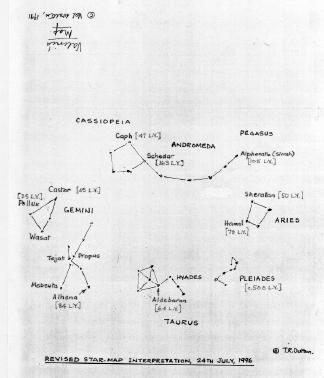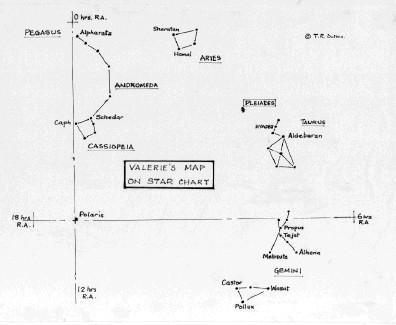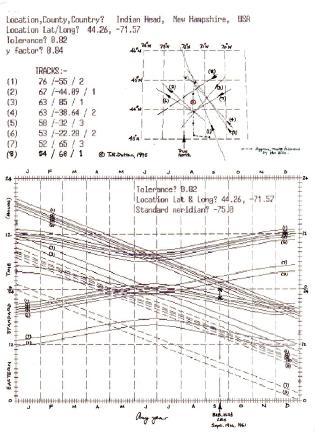UFOs in Reality (23 page)
Authors: T.R. Dutton

I went back to the analysis of that drawing with new eyes, reasoning if that one feature there represented the Pleiades, were there now other star arrangements in the sky, adjacent to that cluster, that might also have been depicted. The problem was one of scale. If the other collections of dots were drawn to the same scale as the Pleiades cluster, then a magnifying glass would be required. Using the magnifier, I searched the sky all round the cluster, but nothing presented itself as being remotely like Valerie’s depictions. So, I decided to search that region of the sky without the magnifier. Fig.40 shows the outcome, labelled on Valerie’s drawing. The first pattern to the right of the Pleiades turned out to be a good representation of The Hyades, also in the constellation, Taurus. Working further to the right, the next two arrangements of stars were found in the constellation of Gemini, Propus, Tejat, Castor and Pollux being among those represented. The trapezium of four stars to the left of the Pleiades was found in Aries, the stars Sheratan and Hamal featuring. The remaining feature of the drawing was eventually identified as a collection of stars spanning three constellations, Pegasus, Andromeda and Cassiopeia. All this is shown by Fig. 40, Valerie’s drawing having been rotated through 180°.

Fig. 40
To satisfy the sceptics (usually astronomers), who would no doubt be thinking that, in an exercise involving joining of dots, all sorts of similar patterns could be found in the sky, I produced Fig
.
41. Here, the star patterns are shown as they appear on a star chart. Can any reasonable person fail to recognise how well Valerie’s drawing depicted these?

Fig. 41
In my view, this is the best breakthrough we have been given in our quest for understanding of the CE4 phenomenon. We may have also been given the clearest indication yet of the area of the sky from which these particular visitors had originated.
Now, it so happens to be true that several contactees (as opposed to ‘abductees’) have claimed that the they had received information that their contacts had come from the Pleiades area. It seemed that Valerie and Rosemary had no knowledge of that. In fact, they claimed to have had no interest in UFO stories, astrology or astronomy before their CE4.
The Barney and Betty Hill CE4
It seems appropriate to end this Phase 5 by considering the first and most famous alien abduction story ever to become widely known. American husband and wife, Barney and Betty Hill, lost their memories of a prolonged interruption of their journey home from a holiday stop in Niagara, after they had encountered an SAC and its alien occupants. What’s more, like Valerie and Rosemary, under hypnosis Betty Hill had produced a drawing to represent something she had been shown by her abductors. She had been told it showed where they had travelled from in the universe. It was a series of small circles and dots with lines drawn between some of them. This drawing was later analysed by an amateur astronomer, who constructed a three-dimensional model of it, by means of small balls hung from the ceiling of a spare room, at different levels and distances apart. She had concluded from this construction that the ETs’ home was within the constellation of Reticulum.
Although the story was extremely challenging, I had originally resisted trying to analyse the circumstances of the Hills event, because it had occurred during a long car journey from the Canadian border to their home in Portsmouth, New Hampshire. On reconsideration, I decided to have a go. Using the account given in the book,
‘The Interrupted Journey’ [16],
published in 1980, and a road map of that area of the USA, I was able to reconstruct the Hills journey, by marking the named stopping points on the map. Although they had been followed by an unidentified light in the sky for some time before, the actual encounter occurred in the lonely White Mountains area of New Hampshire. Using the times when each location had been reached by the couple, the AT programs enabled me to compute the data and to determine whether any of the information given by the book was in agreement with the AT’s predictions for each location.
To my amazement and satisfaction, I found very good correlations between the actual events and the predictions. The following graph (Fig. 42) shows the details of the analysis and will be followed with a detailed account of its features.

Fig. 42
The Hills home was in Portsmouth, New Jersey and this coastal location is marked on the latitude/longitude map. All the other key places are also marked on that little grid map. Please refer to that map whilst reading the following account of their journey.
During September, 1961, after a touring holiday, which they terminated at Niagara Falls, they began their return home via Montreal, Canada. On September 19th they turned southwards to get onto US Route 3. They left the Canadian border post at about 9pm, expecting to arrive home about 3am next morning. They then stopped at Colebrook for refreshments and left there at 10:05pm. Their route home took them through the lonely Connecticut River Valley and then into the rugged Pilot Range of mountains. The moon lit up the scenery as they progressed and a bright planet was noticed near to the Moon. This, I judged, would have been Jupiter, accompanied in the sky by another planet, Saturn. Then, they noticed another bright light in the sky and, when they stopped to walk their dog, they perceived it was moving and gradually getting larger. It seems that this unidentified light, which later became recognisable as an SAC, arrived on their scene shortly before 11pm.
They stopped again at 11pm to view the object through binoculars. It had flashing lights, but it was definitely not an aircraft. As they drove on to Indian Head, a huge craft with windows suddenly swung low across the road ahead.
Through binoculars, occupants were clearly visible behind the lighted windows. The SAC hung over the field to one side of the car. The Hills remembered driving off in terror, hearing beeping noises inside the car and then feeling drowsy. The beeps returned and the car was still in motion. A signpost told them they were then 35 miles further along the road. Only when they entered US Route 93 did they become fully aware of their situation. They had no recollection of that 35 miles from Indian Head southwards. Subsequently, they arrived home two hours later than expected.
It’s time now to consider the analysis of these details.
The SAC (UFO) was first sighted at about 11pm Daylight Saving Time (DST), that is, 10pm EST as plotted on the timings graph. The lower black cross represents that event. It is lying on the Sunset Track No.2 timing line.
If we now assume that the Close Encounter occurred soon afterwards and that it was responsible for a subsequent two-hour memory loss, the CE4 would have been terminated at about midnight EST, as shown by the upper black cross. That cross is lying on Star-related Track No. 6 and this is suggesting that the SAC was retrieved by a retrieval spacecraft moving East-West in space above that location.
Looking again at the latitude/longitude grid map, the No.2 track line runs close to the Canadian border post, so that could have been where the Hills car was detected and followed by the atmospheric scout craft. The No.6 track crosses the Hills route 23 miles south of Indian Head, as drawn and, therefore accounts for many of their lost journey miles, if that track had been used by the retrieval craft.
Despite slight discrepancies, I was pleased with this result, since it explains both the missing time and the unaccounted-for journey miles.
References
[16] Fuller, J.G.‘The Interrupted Journey” (paperback) CORGI Books, Transworld Publishers, Ealing, London. 1981 Souvenir Press, 1980 (book)
CHAPTER 16
T
HE SMOKE-ALARM EXPERIMENT
During the summer of 1993, on June 6th, just before we moved to Devon, my wife, Marion, and I were awakened from sleep in the early hours of the morning. As we lay wondering why we’d been disturbed at 2:45 am (BST) a loud bleep from the adjoining hallway answered that question. “It’s that damned smoke
-
alarm”, I said, not in the least amused. I waited a few minutes, but there were no further bleeps from it. It dawned on me that this was unusual because when the battery had needed replacing in the past, the bleeps had continued at one minute intervals. I got out of bed and tested the offender using the test button provided. The noise from it nearly deafened me. Surely, there was nothing wrong with the battery, so I decided not to disconnect it, much to Marion’s disapproval. At 3:10 am. the thing went off again and, in the same way as previously, the bleeping stopped of its own accord. Marion’s disapproval of my determined non-action became rather irritable, but I was intrigued by it all – lost sleep or no lost sleep! “It’s all in the cause of Science”, I said. (She’d heard that excuse before!) We then rested in peace until 4:25 am and further bleeps at 5:10 am. and 5:30 am. ensured that little sleep could be had during that period. However, we were able to sleep thereafter until our normal getting-up time. As we were both now in retirement and would be moving around the bungalow all day, I said I was going to monitor the alarm at frequent intervals to check whether it was going to continue its bad behaviour during daylight hours. But, first, I checked the voltage of the battery. I knew that standard 9v batteries needed replacing when the voltage dropped to 8.2v and, with the alkaline variety, this critical voltage was 7.8v. The normal battery in our alarm gave me a voltage of 8.6v. So, there should have been no problems.
Remembering Mrs. Linda Jones’ experiences and the resulting speculation that perhaps some kind of RF scanning might account for them, (see Part 3, Chapter 21), I wondered if that might also be the cause of our smoke-alarm’s strange behaviour. This prompted me to check the times of our disturbed sleep against the AT’s timing graph for our area. The result was quite startling. Correlation was generally within half-an-hour of predictions and usually less than that. Significantly, there were no bleeps from the alarm during the daylight hours, but they began again at 8:15 pm, 8:35 pm and 8:50pm. (These were shown to correlate well with East Didsbury time predictions, East Didsbury being only about seven miles away). Then there was silence until 10:10 pm and 10:30 pm. Another silence followed until 11:25 and 11:40 pm. All these were in good agreement with predictions. After showing this to Marion, I persuaded her to allow her sleep to be broken for yet another night and, sure enough, it was! There were four interruptions between 2:06 and 5:10 am, before silence reigned supreme until 7:25 and 8:10 am. During that morning of June 7th, the alarm bleeped twice during a 10-minute period at 8:20 am. and three times from 10:03 and 10:30 am.
The important feature of these interrupted outbursts was that no adjustment could be made to the battery voltage when the alarm was still mounted on the wall.
Having ascertained that correlation with predictions had been very impressive throughout, as shown by Fig. 43, I decided to work on the hypothesis that RF scanning might have interfered with the delicate electrical balance within the circuits of the ionisation-chamber smoke alarm.
